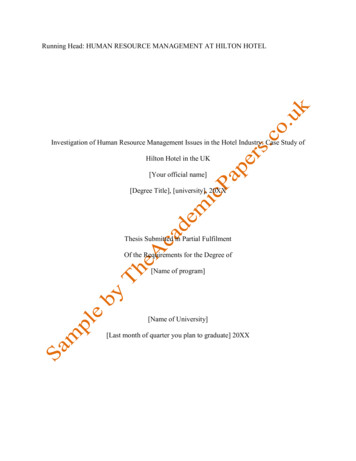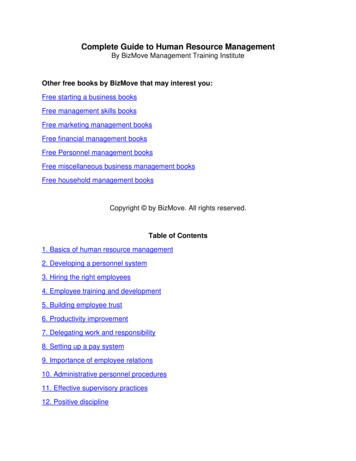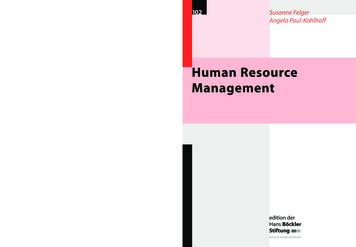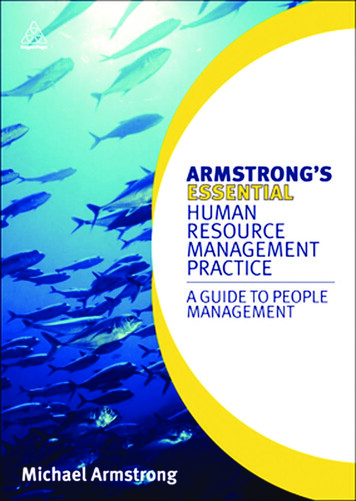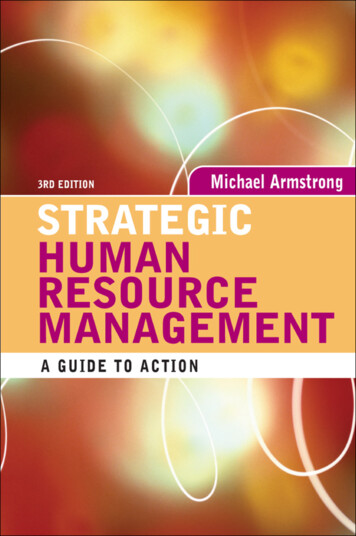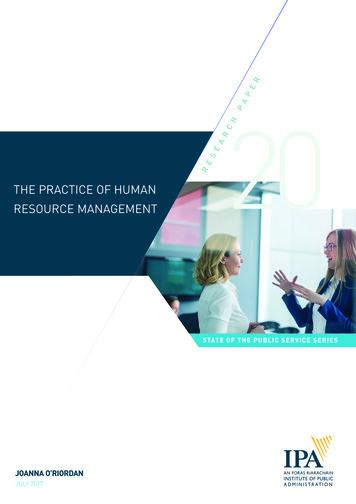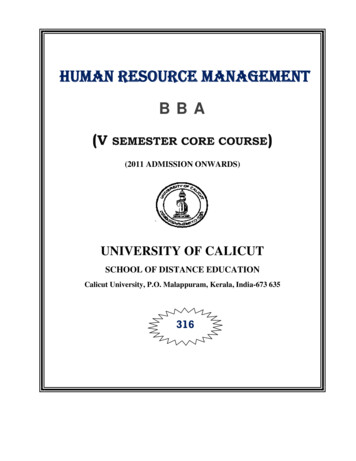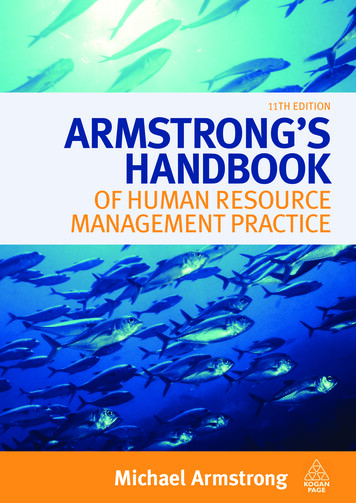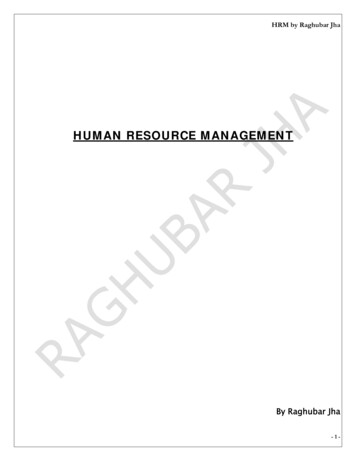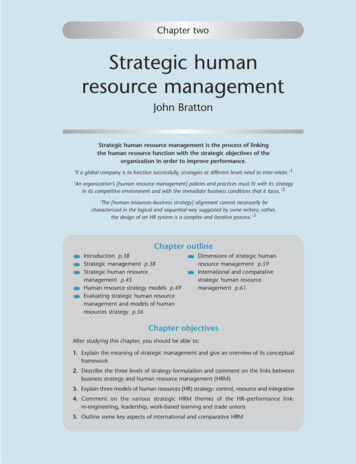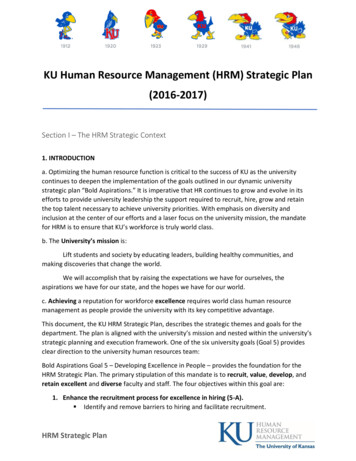
Transcription
KU Human Resource Management (HRM) Strategic Plan(2016-2017)Section I – The HRM Strategic Context1. INTRODUCTIONa. Optimizing the human resource function is critical to the success of KU as the universitycontinues to deepen the implementation of the goals outlined in our dynamic universitystrategic plan “Bold Aspirations.” It is imperative that HR continues to grow and evolve in itsefforts to provide university leadership the support required to recruit, hire, grow and retainthe top talent necessary to achieve university priorities. With emphasis on diversity andinclusion at the center of our efforts and a laser focus on the university mission, the mandatefor HRM is to ensure that KU’s workforce is truly world class.b. The University’s mission is:Lift students and society by educating leaders, building healthy communities, andmaking discoveries that change the world.We will accomplish that by raising the expectations we have for ourselves, theaspirations we have for our state, and the hopes we have for our world.c. Achieving a reputation for workforce excellence requires world class human resourcemanagement as people provide the university with its key competitive advantage.This document, the KU HRM Strategic Plan, describes the strategic themes and goals for thedepartment. The plan is aligned with the university’s mission and nested within the university’sstrategic planning and execution framework. One of the six university goals (Goal 5) providesclear direction to the university human resources team:Bold Aspirations Goal 5 – Developing Excellence in People – provides the foundation for theHRM Strategic Plan. The primary stipulation of this mandate is to recruit, value, develop, andretain excellent and diverse faculty and staff. The four objectives within this goal are:1. Enhance the recruitment process for excellence in hiring (5-A). Identify and remove barriers to hiring and facilitate recruitment.HRM Strategic Plan
Implement the Hiring for Excellence protocols.2. Develop and retain talent and leadership at all levels to thrive in an era of change (5B). Expand and enhance training, mentoring and leadership developmentopportunities. Increase the visibility and recognition of KU faculty and staff expertise. Enliven the KU campus community with eminent visitors and local communitytalent.3. Be accountable (5-C). Develop and implement university-wide faculty policies for post-tenure reviewand mentoring. Utilize differential faculty workloads to enhance productivity. Encourage ongoing two-way performance evaluation.4. Enhance diversity of faculty, staff and students (5-D). Elevate the diversity leadership position to a vice provost level. Provide university oversight for diversity and equity faculty, staff and students. Develop and implement a campus vision and plan to coordinate diversity efforts.Metrics established to determine progress toward the implementation of Goal 5 are: Professional development participation of faculty and staff.Numbers of minority faculty members, staff and students.Appointment processing time.To be truly successful in our efforts there must be a strong linkage between outcomes andinputs. HRM programs/efforts must be aligned to deliver on university goals and be rationalizedby understandable analytics. Data and the decision that it drives help leaders know how theirefforts are meeting university goals/objectives. While the KU HR function is doing well, there ismuch we can do to better align our efforts with the needs of campus wide stakeholders.2. HUMAN RESOURCE MANAGEMENT – OVERVIEW OF THE CURRENT STATEHuman Resource Management is organized into a central office, seven functional directoratesand data and information systems offices. The human capital function is aligned under the ViceProvost for Administration and Finance in the Provost Office. Faculty appointments andadministrative support is closely coordinated with the Vice Provost for Faculty Development.HRM Strategic Plan
The current organizational structure of HRM is available artThis structure was implemented in 2015 as part of the Provost Office led Changing forExcellence (CFE) initiative. The reorganization occurred at the same time that the universityimplemented a shared service initiative. The Shared Service Centers (SSCs) are designed toabsorb much of the transactional personnel actions at the university that used to be splitbetween units and central HR. HRM and the SSCs are in the process of more clearly definingroles and responsibilities for each organization. This version of the HRM strategic plan will beshaped with the assumption that the migration of transactional HR processing to the SSCs iscomplete.3. THE HRM OPERATING CONTEXTHuman Resource Management reflects the centralized/strategic human capital function thatoperates within a complex and dynamic environment. There are a range of both external andinternal challenges that intersect with the unique KU culture(s). The role of HRM within thiscomplex environment is to provide advice and support to university leaders from theChancellor through line management to optimize the performance of KU’s large and diverseworkforce.a. The operational model for HRM that reflects our support of university leaders and ourresponsibility to the workforce is articulated in the following diagram:HRM Strategic Plan
This blueprint highlights the importance of making HR services more accessible to ourcustomers throughout the lifecycle of their employment with the university. This customercentric emphasis is balanced with an understanding that HR is also responsible for the drivingthe continuous growth of strategic talent across the university.Three principles at the heart of the HRM operating model are:1. Alignment with the university mission: mapping HR processes and outcomes to studentsuccess and facilitating successful research has to guide how we operate. A 2016-2017 HRMaspiration is to define how we measure our work relative to student and research success.2. Agility is key. When HRM demonstrates agility, flexibility and collaboration, it unlocksefficiency and effectiveness throughout the university.3. Continuous growth and evolution is imperative. The world around us is changing and thenature of higher education is continually evolving – we have to be prepared to shatter theboundaries of HR functions at the university to stay relevant to our customer.Leveraging technology is fundamental to fully realizing the potential of the university HRoperating model. A key feature of the model is an emphasis on digital excellence: cloud-baseddelivery, technologies that facilitate collaboration, and analytics capabilities to deliver timelyinsights.HRM Strategic Plan
EXTERNALINTERNALb. A SWOT analysis of HRM provides the foundation to understand the organization’s operatingcontext at the university.HELPFUL(for our mission/goals)Strengths Exceptional functional expertise Mature HR processes and services Superior customer service mentality Relatively flat organizationalstructureOpportunities Partnership expansion Data driven customer support HR Brand Management Differentiation of HR services fromHRM to SSCs to units Career management fluidity Establish a clear “seat at the table” Implement lean practices Improve employee-facing HRsystems Improved external communicationsHARMFUL(for our missions/goals)Weaknesses Transactional vs. Strategic Integrated and synchronized services Organizational self-assessment/growthmechanism Systemic employee development Immature data approach Holistic employee recognition protocolThreats Fiscal environment Holistic/integrated HR approach acrossall employee classes Info systems – currency andintegration Synchronization of HR with theuniversity strategic directionSustained fiscal challenges will continue to impact the pace of change that HRM is able tosustain across our numerous initiatives. Of particular note is the delay in implementing updatesto our core information system (People Soft – HR/Pay). There will also remain a degree ofbureaucratic inefficiency as long as the personnel function for our staff and faculty populationsremains largely separate.Internal to HRM there is a lack of integration across all of our units. There is also a lot of spaceto further the personal and professional development of the HR team. Truly transitioning thedepartment to a data based decision model remains illusory but critical to our success. It is alsoimperative that HRM deepen our self-evaluation/lessons learned process as we remaincommitted to a culture of continuous improvement.At the same time, the organization has an amazingly capable and committed workforce. Ourprocesses are generally meeting the needs of our customers and in many instances reflectindustry best practices. Our commitment to always looking for ways to improve end-userexperience is notable and an area to sustain.HRM Strategic Plan
Growth opportunities are numerous even though, pragmatically, they need to be prioritizedbased on fiscal and staff capacity constraints. A data driven customer support model remains aclear top priority. It is also important to stay engaged across campus with a deliberate effort toimprove and sustain our brand awareness.The following section outlines 2016-2017 HRM priorities as we look to better align our workwith university strategic imperatives and address both the challenges and opportunitieshighlighted above.Section II – Vision, Mission, Values and Goals1. Vision Statement:Empowering a Community of Excellence2. Mission Statement:Through the delivery of innovative, valuable and timelyservices, HRM guides and supports an inclusivecommunity of excellence where people flourish.3. HRM ValuesIntegrity by Always treating others with respect, courtesy and fairness. Maintaining confidentialityand professionalism at all times.Diversity by Recognizing and respecting the value of differences; acknowledging and appreciatingthe contributions of others.Freedom of expression by Expressing candid views without the fear of recrimination; encouraging andacknowledging new ideas.Team spirit by Communicating openly and honestly in a constructive and supportive manner; sharingideas and resources.Accountability by Taking personal and professional responsibility for our actions, maintaining aconsistently high level of performance. Promote transparency in decision-making.Excellence by Establishing a high performance culture designed to achieve exceptional outcomes.HRM Strategic Plan
4. Strategic Themes for Human ResourcesKU’s success is largely dependent upon the quality, reputation and productivity of its people(human capital). Human Resource Management is committed to regular analysis of our servicesto ensure that we are addressing the long term people needs of the university. Over the next 12to 18 months HRM will focus on the following five strategic themes:1. Recruit and retain a highly talented and diverse workforce. Recruitment is about the abilityof the university to source new employees, keep the organization operating and improvingthe quality of the human capital employed in units across campus. The quality of therecruitment process is the main driver for the satisfaction of managers with the servicesprovided by Human Resources.The goals associated with this strategic theme include: Develop and resource a formal staff recruitment strategy. Integrate a focus on workforce diversity into all aspects of the recruiting process. Establish a centralized job posting/advertising initiative. Complete the integration of Brass Ring/IBM onboarding with HR/Pay. Redesign new employee orientation. (Aspirational) Manage the executive recruitment process for the university. (Aspirational) Consolidate faculty recruitment, onboarding and retention efforts withinHRM.2. Enhance (and measure) end-user experience. At the core of HRM’s business model iscustomer service. Our ability to provide the right information in a timely manner will defineour value to our campus business partners. Nested within this foundational responsibility isthe ability to measure the impact we are having on the university – both positive andnegative. Ultimately we will improve our support by using data to drive the decisions thatwe are making.The goals associated with this strategic theme include: Evolution/refinement of the HR tiered customer service model. Transition from Fresh Desk to Service Now. Develop and implement an HR technology plan. Establish data-driven decision making protocols for each department. Sustain the HR brand awareness effort.3. Grow the KU workforce. Our university needs a vibrant, skilled and engaged workforce. Asthe university continues to evolve the capacity of our employees needs to grow to meet thedemands of running an increasingly complex organization. In recent university-wide surveysprofessional development has consistently been identified as the top concern of ouremployees.HRM Strategic Plan
The goals associated with this strategic theme include: Full implementation of performance management and a campus wide commitment to acontinuous employee engagement model. Integration of the learning management system with the performance managementmodule. Fully implement recommendations from “Leading Up the Hill”/build content consistentwith the Learning Development Roadmap recommendation.4. Workplace culture enhancement. A positive culture unleashes the power and energy ofeach of our employees. A great culture is a living entity and needs to continue evolving overtime. Organizations get the best out of their people by establishing a one-team mindset andan attitude of trust.The goals associated with this strategic theme include: Sustained commitment to diversity and inclusion with HRM leading inclusion efforts. Co-lead the execution of and follow-up to the Campus Climate Survey. Strengthen accountability protocols across campus. Maintain compensation visibility and commit to providing a competitive andappropriate salary for each employee.5. (Aspirational) Workforce Strategic Planning. Workforce planning is a systematic, fullyintegrated organizational process that involves proactively planning ahead to avoid talentsurpluses or shortages. It is based on the premise that the university can be staffed moreefficiently if we forecast our talent needs as well as estimating the actual supply of talentthat is or will be available.The goals associated with this strategic theme include: Affirmative Action planning that supports shaping the right workforce. Cross campus analysis of the current “people” status in each unit including a 1-3-5-10year trend analysis. Establish a workgroup to map the university business strategy against the universitypeople strategy5. Action Plans:Strategic Theme 1: Recruit and retain the best possible workforce.ObjectiveCompletionAction StepsResponsibilityKPI1.1 (Proposed Goal) Develop and resource a formal staff recruitment strategy. (Angie willform a work group in Oct 16 with an intent to launch a pilot strategy within Admin & FinanceHRM Strategic Plan
prior to the end of AY 17. A key element of the strategy will be improving KU’s diversity hiringprotocols.)1.1aFall 2016Form work groupAngie LovingNA1.1bSpring 2017Conduct pilotAngie Loving% diverse hiresObjectiveCompletionAction StepsResponsibilityKPI1.2 (Proposed Goal) Establish a centralized job posting/advertising initiative.1.2aFall 20173G integrationAngie LovingPost to hire toonboard time1.2bSummer 2018Campus wideAngie LovingPost to hire toby summer 18onboard timeObjectiveCompletionAction StepsResponsibilityKPI1.3 (Proposed Goal) Complete the integration of Brass Ring/IBM onboarding with HR/Pay.1.3aFunctional by 15Person dataPam Burkhead% employeesDec 16integrationnot manuallykeyed1.3bFully functional by Full dataPam BurkheadSAB1 Jul 17integrationObjectiveCompletionAction StepsResponsibility1.4 (Proposed Goal) Redesign new employee orientation.1.4aFall 16Add diversityL&D and OMAprogram awareness1.4bSummer 171.4c1.4dSummer 17Summer 17Provide both on-lineand instructor ledMandatory for staffEstablish a phase IIIredesign work groupL&DHRMKathleen AmesStrattonKPI% newemployeescompletingSABSABTBDStrategic Theme 2: Enhance (and measure) end-user experience.ObjectiveCompletionAction StepsResponsibility KPI2.1 (Proposed Goal) Evolution/refinement of the HR tiered customer service model.2.1aFall 16FreshDesk refresherAbby/Mike% HRM stafftrainingcompleted2.1bOn-goingExpansion of FrontAbby/Mike% Tier 2 to TierOffice Tier 1 capacity1 task transitionHRM Strategic Plan
2.1cFall 16Integrate unit FreshDesk response ratesinto Director MeetingAbby/MikeObjectiveCompletionAction StepsResponsibility2.2 (Proposed Goal) Transition from Fresh Desk to Service Now.2.2aTBDServiceNow trainingBarbaracompleted2.2bTBD2.2cTBDHRM ticketing systemconverted from FreshDesk to Service NowIntegrate Service Nowcustomer mpletion Action StepsResponsibility2.3 (Proposed Goal) Develop and implement an HR technology plan.2.3aFall 2016Data group shapes theBarbarainitial framework2.3bSpring 2016 Publish the completedMikeplan/campuscommunicationcomplete% of ticketsclosed on timeKPI% of HRM staffcompleted &certified% of HRMactions ticketedin Service NowCustomerfeedbackvolume bycategoryKPITBDTBDObjectiveCompletion Action StepsResponsibilityKPI2.4 (Proposed Goal) Determine what data-driven decision making means for eachdepartment.2.4aFall 2016Extend HRM metrics to Daniel/Mike/Angie % ofcover bSpring 2016 Initial metricsDaniel/Mike/% ofestablished for Benefits, Madi/AllenemploymentEmployee Relationsengagementstracked2.4cFall 2017HRM Metrics complete Daniel/Mike% of(including HR/Pay)employmentengagementstrackedHRM Strategic Plan
ObjectiveCompletion Action StepsResponsibility2.5 (Proposed Goal) Sustain the HR brand awareness effort.2.5aFall 2016Conduct the HRM Brand Mikecampaign in partnershipwith the Agency2.5bSpring 2016 Coordinate HRM nextsteps Brand awarenessMike/AbbyKPI# of websitehits for HRMbrandcampaignTBDStrategic Theme 3: Grow the KU workforce.ObjectiveCompletion Action StepsResponsibility KPI3.1 (Proposed Goal) Full implementation of performance management and a campus widecommitment to a continuous employee engagement model.3.1aSpring 2017 Phase III of the KUMike% ofperformance systememployeesimplementation is completew/on-timeperformanceevals3.1bSpring 2017 Continuous performanceKatie% ofmanagement trainingemployeescompletingtraining3.1cFall 2017Continuous performanceMike/KatieSABmanagement implementedacross A&FObjectiveCompletion Action StepsResponsibilityKPI3.2 (Proposed Goal) Integration of the learning management system with the performancemanagement module.3.2aSpring 2017 Cost analysis of systemBarbara/MikeCost vs.integration completeresources3.2bFall 2017System integrationBarbara/Mike% integrationcompleteof LMS/PMStransactionsObjectiveCompletion Action StepsResponsibilityKPI3.3 (Proposed Goal) Fully implement recommendations from “Leading Up the Hill”/buildcontent consistent with the Learning Development Roadmap recommendation.HRM Strategic Plan
3.3aFall 20163.3bFall 20173.3cTBDAspiring Leadercertification programpilot is completeAdministrator leadershipcertificate program pilotis completeProject leader certificateprogram is umapprovedJami/KathleenCurriculumapprovedStrategic Theme 4: Workplace culture enhancement.ObjectiveCompletion Action StepsResponsibility4.1 (Proposed Goal) A focus on inclusion is central to all aspects of HRM efforts.4.1aFall 2016Inclusion/accessibilityMikeconsiderations formallyadded to all HRM planningand projects4.1bSpring 2017 HRM partners with D&E to Mikelead the development of auniversity diversitystrategic plan (post ClimateStudy Survey)ObjectiveCompletion Acti
Develop and resource a formal staff recruitment strategy. Integrate a focus on workforce diversity into all aspects of the recruiting process. Establish a centralized job posting/advertising initiative. Complete the integration of Brass Ring/IBM o

